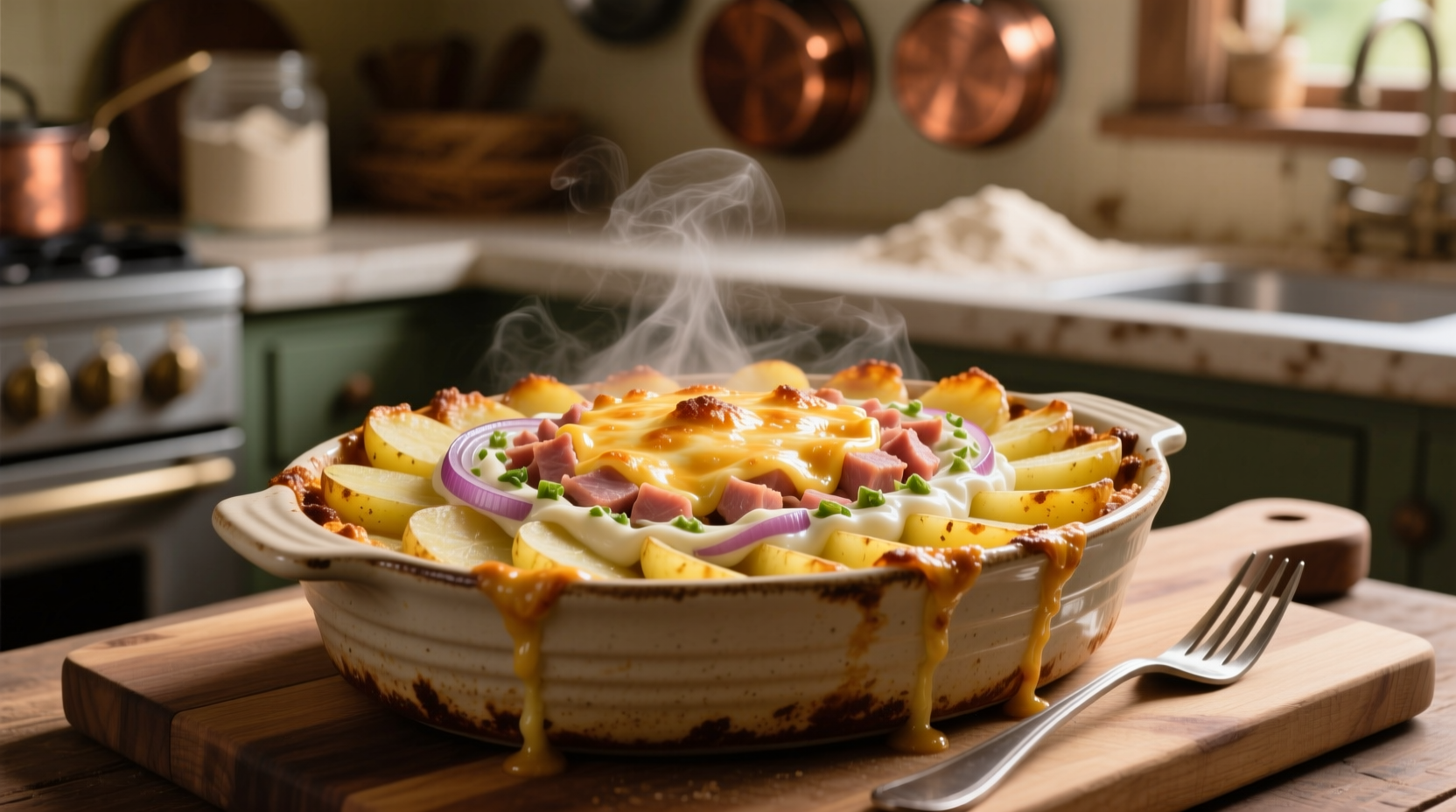Nothing says comfort food quite like a perfectly baked ham and potato casserole. This beloved dish combines humble ingredients into a satisfying meal that's equally at home on weeknight dinner tables and holiday buffets. Whether you're using holiday leftovers or planning a cozy family dinner, mastering this casserole technique opens the door to endless culinary possibilities.
Why Ham and Potato Casseroles Work So Well
The magic of ham and potato casseroles lies in their perfect flavor and texture synergy. Potatoes provide a neutral canvas that absorbs surrounding flavors while developing crispy edges during baking. Ham contributes savory depth and saltiness that enhances the entire dish. When combined with creamy elements like cheese or sauce, they create a satisfying contrast between crispy top layers and tender interior components.
Food science explains why this combination works: potatoes contain starch that gelatinizes during cooking, creating a creamy texture, while the Maillard reaction on the ham's surface develops complex umami flavors. The moisture from both ingredients creates steam during baking, preventing dryness while allowing the top layer to crisp beautifully.
Essential Ingredients and Their Roles
Understanding each component's purpose helps you make informed substitutions without compromising quality:
| Ingredient | Primary Function | Professional Tip |
|---|---|---|
| Yukon Gold Potatoes | Texture foundation | Waxy varieties hold shape better during baking |
| Smoked Ham | Flavor anchor | 72-hour smoked varieties add deeper complexity |
| Sharp Cheddar | Creaminess enhancer | Pre-shredded contains anti-caking agents that affect melt |
| Heavy Cream | Moisture regulator | Substitute with evaporated milk for lighter version |
Step-by-Step Preparation Guide
Follow this chef-approved method for guaranteed success every time:
Prep Phase: Setting Yourself Up for Success
Begin by selecting quality ingredients. For potatoes, Yukon Golds offer the ideal balance of starch and moisture. Russets work too but require careful monitoring to prevent drying. When choosing ham, look for pieces with visible marbling—this fat renders during baking, basting the potatoes from within.
Professional kitchens always par-cook potatoes before assembling casseroles. Boil sliced potatoes for 8-10 minutes until just tender when pierced with a fork. This crucial step ensures even cooking and prevents raw potato centers. Drain thoroughly and let cool slightly while preparing other components.
Assembly Technique: Building Flavor Layers
The layering method significantly impacts final texture. Start with a thin coating of butter or oil in your baking dish to prevent sticking. Then alternate layers:
- Bottom layer: ⅓ potatoes + ½ ham + ⅓ cheese + seasoning
- Middle layer: Remaining potatoes + remaining ham + remaining cheese
- Top layer: Cream mixture + additional cheese for browning
Press down gently after each layer to eliminate air pockets. The cream mixture (heavy cream blended with Dijon mustard, garlic powder, and black pepper) should be poured slowly over the top layer, allowing it to seep through the layers naturally.

Perfect Baking Conditions
Temperature control makes or breaks your casserole. Preheat oven to 375°F (190°C)—high enough to create browning but low enough to cook through without burning. Bake covered with foil for 30 minutes, then remove foil and increase temperature to 400°F (204°C) for final 15-20 minutes.
Doneness indicators include:
- Bubbling edges visible around the dish
- Internal temperature reaching 165°F (74°C) when measured in center
- Golden brown top with crispy cheese edges
- Knife or skewer inserting smoothly into center potato
Customization Options for Every Occasion
One reason ham and potato casseroles remain popular is their adaptability. Consider these professional variations:
Dietary Adaptations
For gluten-free versions, replace any flour-thickened sauces with cornstarch or arrowroot. Dairy-free alternatives work well when using full-fat coconut milk instead of cream and nutritional yeast for cheesy flavor. The USDA Food Safety and Inspection Service confirms that properly heated casseroles reach safe internal temperatures regardless of dairy substitutions (fsis.usda.gov).
Regional Flavor Twists
Add cultural flair with these chef-inspired variations:
- American South: Incorporate Vidalia onions and a dash of hot sauce
- French Provincial: Use Gruyère cheese with fresh thyme and white wine
- Scandinavian: Add dill and substitute sour cream for half the cream
Troubleshooting Common Issues
Even experienced cooks encounter challenges with casseroles. Here's how to solve frequent problems:
Soggy Bottom Syndrome
This occurs when potatoes release too much moisture during baking. Prevent it by:
- Par-cooking and thoroughly draining potatoes
- Sprinkling a thin layer of breadcrumbs on the bottom
- Using a metal or ceramic dish instead of glass
Dry or Rubbery Texture
Overbaking or improper moisture balance causes this issue. Fix it by:
- Measuring cream precisely (1 cup per 2 lbs potatoes)
- Checking temperature 5 minutes before expected finish time
- Covering with foil if top browns too quickly
Serving and Storage Guidelines
For optimal flavor development, let casseroles rest 10-15 minutes after baking. This allows the structure to set, making serving cleaner. Garnish with fresh chives or parsley for color contrast against the golden top.
Store leftovers in airtight containers in the refrigerator for up to 4 days. Reheat individual portions in the oven at 350°F (177°C) for best texture retention—microwaving often makes potatoes rubbery. The National Center for Home Food Preservation confirms that properly stored casseroles maintain quality when frozen for up to 3 months (nchfp.uga.edu).
Why This Dish Endures Across Generations
Ham and potato casseroles have maintained popularity since the 1950s when American households embraced convenience cooking. Their staying power stems from practical advantages: they transform leftovers into new meals, feed crowds economically, and travel well for potlucks. Modern adaptations keep the dish relevant while honoring its comforting roots.











 浙公网安备
33010002000092号
浙公网安备
33010002000092号 浙B2-20120091-4
浙B2-20120091-4